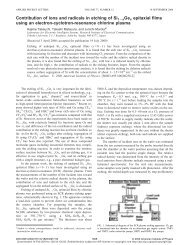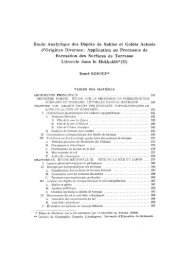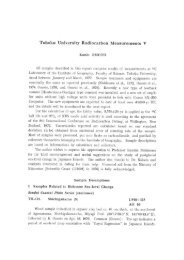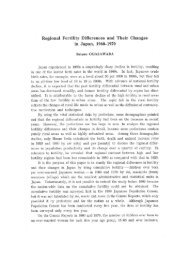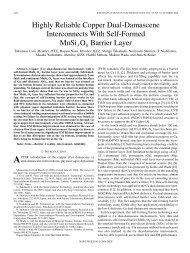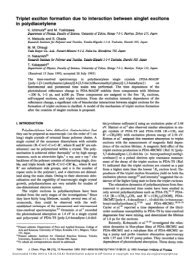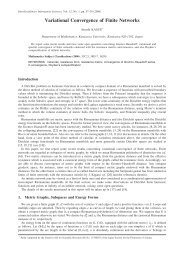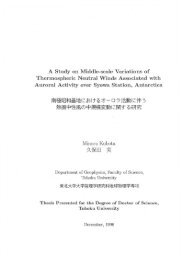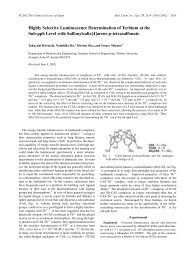Sulphidization of Metal Oxides by Means of Mechanochemical Solid ...
Sulphidization of Metal Oxides by Means of Mechanochemical Solid ...
Sulphidization of Metal Oxides by Means of Mechanochemical Solid ...
Create successful ePaper yourself
Turn your PDF publications into a flip-book with our unique Google optimized e-Paper software.
1094 ChemistryLetters 2002<br />
<strong>Sulphidization</strong> <strong>of</strong> <strong>Metal</strong> <strong>Oxides</strong> <strong>by</strong> <strong>Means</strong> <strong>of</strong> <strong>Mechanochemical</strong> <strong>Solid</strong> Reaction<br />
Qiwu Zhang, Jun Wang, Fumio Saito, Takahiko Okura, y and Isao Nakamura y<br />
Institute <strong>of</strong> Multidisciplinary Research for Advanced Materials, Tohoku University, Sendai, 980-8577<br />
y Nikko Techno Services Co., Ltd., Tokyo 105-0001<br />
Co-grinding nonferrous metal oxides and sulphur together<br />
with iron/aluminium metal stimulates a solid-state reaction to<br />
form the nonferrous metal sulphides and iron/aluminium oxide,<br />
allowing the use <strong>of</strong> the current mineral processing technologies to<br />
recover metals from various kinds <strong>of</strong> wastes.<br />
<strong>Metal</strong>s are the keymaterials to support material civilization.<br />
Theyhave been widelyused and a vast amount <strong>of</strong> waste arises<br />
after the use <strong>of</strong> the materials. In the cases <strong>of</strong> nonferrous metal such<br />
as Cu, Pb, Zn in Japan, for example, amount as high as 10–30% <strong>of</strong><br />
their outputs annuallyhas been discarded in various types <strong>of</strong><br />
waste. Recycling these metals from the wastes are highly required<br />
from the points <strong>of</strong> environmental resource preservation and<br />
sustainable development. These metals are mainlyobtained <strong>by</strong><br />
processing sulphide minerals such as sphalerite (ZnS), ganela<br />
(PbS), and charcopyrite (CuFeS2). There have been existing<br />
efficient technological systems to process these sulphide minerals.<br />
However, the states <strong>of</strong> metals in the wastes are rare in sulphide<br />
but oxide and oxidized compounds besides metals. When a simple<br />
and reliable method to sulphidize the metals in the waste is<br />
developed, the existing mineral processing and metallurgical<br />
technologies can be applied to treat these synthetic sulphides,<br />
making the metal recycling system feasible technologically and<br />
economically, compared to the difficulty in the specific development<br />
<strong>of</strong> a new recycling processes for each specific kind <strong>of</strong><br />
wastes. 1{5 Efforts have been reported for the sulphidization, such<br />
as high temperature reaction and precipitation from solution using<br />
H2S and other sulphides. 6;7 As the sulphides are used as<br />
sulphidizer, it is difficult to avoid the secondaryemission <strong>of</strong><br />
wastes as well as the release <strong>of</strong> toxic gases <strong>by</strong>these methods. In<br />
addition, it entails the acid leaching <strong>of</strong> the wastes to extract metals<br />
into solutions before the precipitation operation. On the other<br />
hand, little attention has been paid on the use <strong>of</strong> element sulphur, 8<br />
<strong>of</strong> which such a great deal has been emitted as <strong>by</strong>products from oil<br />
refinery, besides the natural occurrence, that an overabundance<br />
state <strong>of</strong> supplyhas to be resolved.<br />
Our research work has shown that a mechanochemical solidstate<br />
reaction induced <strong>by</strong>a simple grinding allows the use <strong>of</strong><br />
sulphur sample to sulphidize both the metals and their oxides<br />
easily. The basic information is reported in this paper. A dry<br />
grinding <strong>of</strong> the starting samples was conducted to stimulate the<br />
solid-state reactions, using a planetaryball mill in air. Nonferrous<br />
metals <strong>of</strong> Cu, Pb, and Zn were chosen as the targets. The ground<br />
samples were mainlycharacterized <strong>by</strong>X-raydiffraction analysis<br />
to determine the phases. The reaction was also evaluated<br />
quantitatively<strong>by</strong>measuring the remaining sulphur in the ground<br />
sample through the CS2 washing.<br />
Each metal <strong>of</strong> Zn, Pb, and Cu was mixed with sulphur at<br />
equimolar ratio and ground for 60 min. The results are shown in<br />
Figure. 1. The results confirm that the following reaction occurs<br />
(Received July12, 2002; CL-020586)<br />
Copyright Ó 2002 The Chemical Society<strong>of</strong> Japan<br />
Z n S<br />
during grinding.<br />
M þ S ¼ MS ðM ¼ Zn, Pb, CuÞ ð1Þ<br />
In other words, the nonferrous metals can be simply<br />
sulphidized <strong>by</strong>just grinding with sulphur sample. In fact, the<br />
changes in the standard Gibbs free energy( G298) 9 <strong>of</strong> the Eq. (1)<br />
are 200:4(Zn), 97:0(Pb), and 53:5 kJ/mol(Cu), respectively.<br />
The negative changes also suggest a thermodynamically feasible<br />
occurrence <strong>of</strong> the reactions. Similarlythe mechanochemical<br />
reactions <strong>of</strong>fer a easymethod to synthesize sulphide materials.<br />
10;11<br />
As for grinding the oxides with sulphur, the reaction given <strong>by</strong><br />
Eq. (2) was not confirmed <strong>by</strong>XRD analysis because onlythe<br />
starting oxides and sulphur were detected after grinding.<br />
MO þ S ¼ MS þ 1=2O2<br />
ð2Þ<br />
In fact the oxides are more stable than the sulfides thermodynamically,<br />
and the reactions have positive G298: 120.1(Zn),<br />
91.7(Pb), and 74.8 kJ/mol(Cu), respectively. How to transform<br />
these oxides into sulphides is vital in the sulphidizing treatment <strong>of</strong><br />
wastes. Our further research has shown that it needs the use <strong>of</strong><br />
additives, functioning as a reductant to the oxides. Additives such<br />
as iron and aluminium metals are found to be effective to induce<br />
the transformation. Using ZnO as a sample and iron powder as an<br />
additive, the occurrence <strong>of</strong> reaction (3) was confirmed <strong>by</strong>the<br />
results shown in Figure. 2.<br />
4ZnO þ 4S þ 3Fe ¼ 4ZnS þ Fe3O4 ð3Þ<br />
With an increase in the grinding time, the peak intensity<strong>of</strong> the<br />
starting samples decreases and becomes unobservable in the<br />
pattern <strong>of</strong> the sample ground for 60 min. Onlythe peaks <strong>of</strong><br />
reaction products are observed in the patterns <strong>of</strong> the sample<br />
ground for over 120 min. In addition, the ground samples were<br />
P b S<br />
C u S<br />
10 20 30 40 50 60 70<br />
2 θ (degree,CuKα )<br />
Figure 1. XRD patterns <strong>of</strong> the nonferrous metal (Zn,<br />
Pb, or Cu) and sulphur mixtures ground for 60 min.
ChemistryLetters 2002 1095<br />
10<br />
180 min<br />
120 min<br />
60 min<br />
15 min<br />
Z n O<br />
S<br />
Z n S<br />
F e O 3 4<br />
F e<br />
20 30 40 50 60<br />
2 θ (degree,CuKα )<br />
Figure 2. XRD patterns <strong>of</strong> the ZnO, S, and Fe mixture<br />
ground for different times.<br />
washed with CS2 solvent and the unreacted elemental sulphur was<br />
measured. Only1.8% sulphur is remaining in the ground sample<br />
after 180 min grinding, indicating that the reaction (3) is almost<br />
completed <strong>by</strong>the time. The G298 <strong>of</strong> reaction (3) is 534:9 kJ/<br />
mol ( 133:7 kJ/mol <strong>of</strong> ZnO), confirming that the addition <strong>of</strong> iron<br />
converts a thermodynamically improbable reaction into a feasible<br />
one. Similar reactions occurred with other oxides such as PbO and<br />
CuO and even the mixtures <strong>of</strong> the oxides when iron was added,<br />
although the grinding time needed to complete the reactions<br />
varied. The iron oxide formed in the ground products is magnetite<br />
so that it maybe separated <strong>by</strong>the magnetic separation. The<br />
formed sulphides can be recovered and separated <strong>by</strong>the<br />
traditional flotation separation.<br />
When a pure sample <strong>of</strong> iron is used, there exists a concern<br />
about the cost. Fortunately, wastes containing iron metal at high<br />
concentration are released from various processes 12;13 and it is<br />
advisable to use these wastes as additives for a practical<br />
application. For example, tens <strong>of</strong> millions <strong>of</strong> used vehicles<br />
destroyed per year <strong>of</strong>fers a vast amount <strong>of</strong> scrap iron. Besides,<br />
manyrecycling processes are also providing iron metal<br />
<strong>by</strong>products from various industrial and domestic wastes. However,<br />
the purity<strong>of</strong> the scrap iron or other <strong>by</strong>products is generally<br />
not so high and the presence <strong>of</strong> other metals such as copper<br />
prevents their direct application as raw material for steel-making.<br />
The <strong>by</strong>products <strong>of</strong>fer an ideal additive for our sulphidizing<br />
process, where the heavymetals in the scrap iron maybe<br />
sulphidized as well.<br />
Similar to iron, the use <strong>of</strong> aluminium powders also brings<br />
about the transformation <strong>of</strong> the oxides into the corresponding<br />
sulphides, being accompanied <strong>by</strong>the formation <strong>of</strong> alumina, as<br />
shown in Eq. (4):<br />
3ZnO þ 3S þ 2Al ¼ 3ZnS þ Al2O3 ð4Þ<br />
And the G298 <strong>of</strong> reaction 4 is 1223:6 kJ/mol ( 407:9 kJ/mol <strong>of</strong><br />
ZnO). Although it is economicallyimpossible to use pure<br />
aluminium as additive to treat waste, this method <strong>of</strong>fers a new<br />
approach to treat aluminium dross waste, which remains as an<br />
environmental problem for aluminium industryand needs proper<br />
treatment. 14;15<br />
In a general word, a novel metal recycling process is<br />
developed: two kinds <strong>of</strong> waste containing nonferrous metals (in<br />
oxide or metal) and iron/aluminium metals, respectively, are<br />
ground with sulphur sample to induce solid-state reaction to form<br />
nonferrous metal sulphides and iron/aluminium oxides. The<br />
existing mineral processing methods such as magnetic and<br />
flotation separation can be applied to the ground sample to<br />
recover the metals. The process also exhibits an environmentfriendlymerit<br />
because most heavymetals are sulphidized and<br />
recovered to leave the waste a non-hazardous residue that can be<br />
stored without problem or can be used in proper fields, besides the<br />
no emission <strong>of</strong> hazardous substance from the process itself.<br />
The authors are thankful to NEDO for the financial support<br />
for the research project (No. 01A42021d).<br />
References<br />
1 T. Nedwed and D. A. Clifford, Environ. Prog., 19, 197 (2000).<br />
2 S. Yoshizaki and T. Tomida, Environ. Sci. Technol., 34, 1572<br />
(2000).<br />
3 J. Jandova, T. Stefanova, and R. Niemczykova, Hydrometallurgy,<br />
57, 77 (2000).<br />
4 J. W. Coetzee and M. Z. Rejaldien, Miner. Eng., 14, 433<br />
(2001).<br />
5 J. R. Parga, J. L. Valenzuela, G. G. Muzquiz, and F. K.<br />
Ojebuoboh, JOM, 53, 19 (2001).<br />
6 H. Katsuura, T. Inoue, M. Hiraoka, and S. Sakai, Waste<br />
Manage., 16, 491 (1996).<br />
7 J. H. Kim, J. G. Yang, and E. Kunugata, Kagaku Kogaku<br />
Ronbunshu, 23, 47 (1997).<br />
8 M. M. C. Alkemade and J. I. A. Koene, Waste Manage., 16,<br />
185 (1996).<br />
9 Barin, ‘‘Thermochemical Data <strong>of</strong> Pure Substances,’’ VCH,<br />
Germany(1989).<br />
10 T. Kosmac and T. H. Courtney, J. Mater. Res., 7, 1519 (1992).<br />
11 P. Balaz, T. Ohtani, Z. Bastl, and E. Boldizarova, J. <strong>Solid</strong><br />
State Chem., 144, 1 (1999).<br />
12 L. Aboussouan, P. Russo, M. N. Pons, D. Thomas, J. P. Birat,<br />
and D. Leclerc, Powder Technol., 105, 288 (1999).<br />
13 R. Boom and R. Steffen, Steel Res., 72, 91 (2001).<br />
14 M. G. Drouet, M. Handfield, J. Meunier, and C. B. Laflamme,<br />
JOM, 46, 26 (1994).<br />
15 R. Narayanan and Y. Sahai, Mater. Trans., JIM, 38, 85 (1997).






